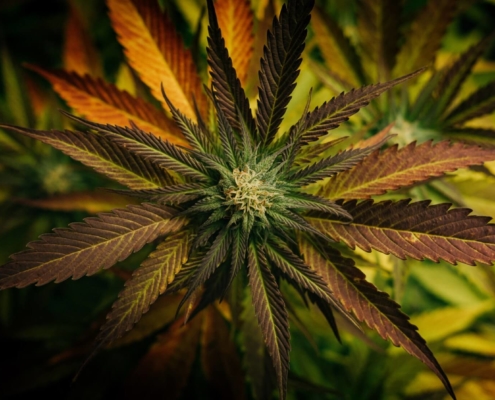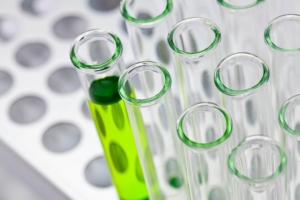Cannabis, Anxiety & Depression
Dr. Genevieve Newton
Anxiety and depression are prevalent and costly mental illnesses, afflicting tens of millions of adults in the United States annually.1 It has been estimated that anxiety has an economic cost of 42.3 to 46.6 billion dollars2 each year in the USA, while 71 billion dollars are spent annually treating depression by individual patients, government, and insurance programs. Depressive disorders are the sixth most costly health condition overall.3 The situation is dire and is getting worse. Anxiety and depression rates have been increasing steadily (especially among young adults),4,5 with significant exacerbations due to COVID-19.6
Both anxiety and depression are widely treated with antidepressants (most commonly selective serotonin reuptake inhibitors, SSRIs) and benzodiazepines. Many patients are unresponsive, and side effects are common. A large analysis of 131 randomized, placebo-controlled trials found that while SSRIs may reduce depressive symptoms, they increase the risk of serious and non-serious adverse events. Researchers concluded that “the potential small beneficial effects seem to be outweighed by harmful effects”, such as dry mouth, dizziness, insomnia, and sexual dysfunction.7 These drugs also have a delayed onset, taking weeks to achieve full efficacy which can lead to poor compliance.8 Given these limitations, it is not surprising that patients are seeking safer and more effective therapeutic alternatives.
 Cannabis has emerged in recent years as a potential treatment for anxiety and depression. Many patients have reported that anxiety and depression were the motivation for seeking cannabis treatment.10 Patients also report using cannabis as a substitute for pharmaceuticals, with 16% using cannabis instead of benzodiazepines and 12% for antidepressants.11 Some people suffering from anxiety and depression also self-medicate with cannabis to improve their symptoms.12
Cannabis has emerged in recent years as a potential treatment for anxiety and depression. Many patients have reported that anxiety and depression were the motivation for seeking cannabis treatment.10 Patients also report using cannabis as a substitute for pharmaceuticals, with 16% using cannabis instead of benzodiazepines and 12% for antidepressants.11 Some people suffering from anxiety and depression also self-medicate with cannabis to improve their symptoms.12
Clearly, patients are turning to cannabis for help. But does it work? Based on the scientific literature, there are caveats to consider. The first consideration is that there is limited research in this area, especially in the clinical sphere. The second is that the relationship between cannabis and mental health (at least for anxiety) is not completely straightforward.
Observational studies on people using cannabis for anxiety have been overwhelmingly positive. In a recently published study, 93.5% of cannabis users tracking symptoms using a smartphone app reported lower anxiety levels after intake.13 Another study found that 71.8% of users reported reducing their prescription anxiety medication.14 Similarly, 93% of medical cannabis users reported that cannabis use reduced their symptoms, although scores remained moderate to high on self-reported anxiety questionnaires.15 The latter observation suggests that cannabis improves, but does not eliminate, symptoms of anxiety.
Post traumatic stress disorder (PTSD) is not classified as an anxiety disorder in DSM-IV, but is characterized by severe anxiety. Cannabis has been shown to improve quality of life, regulate sleep disturbances, and decrease hyperarousal. 16,17 One study showed more than a 75% reduction in PTSD symptoms (including anxiety) when patients were actively using cannabis.18 However, PTSD studies are not unequivocal. It has also been found that when veterans initiated cannabis use after treatment for PTSD, their symptoms worsened compared to those who ceased taking cannabis or never used it.19 Taken together, observational research supports the idea that cannabis may reduce anxiety, although more investigation is needed.
There is scant published clinical research on cannabis and anxiety. There are many reasons for this. One may be that cannabis has the ability to both increase and decrease anxiety, depending on dose. This is known as a “biphasic” effect, and it has been demonstrated in research studies using both animals and humans. Cannabis affects anxiety in a dose-dependent manner, with low doses possibly reducing anxiety (an anxiolytic effect) and high doses possibly increasing anxiety and panic.20,21,22 In rodent studies, the doses of THC that reduce anxiety are less than 1mg/kg of body weight, while the doses that increase anxiety are up to 10mg/kg.23
The effects of different doses of THC on anxiety in humans are not as clearly delineated. One study found that treatment with 12.5mg of THC resulted in higher anxiety and anticipatory distress than either placebo or 7.5mg of THC.24 A review article suggested that more than 5mg of oral THC can cause intense fear and anxiety in some cases.25 It is especially difficult to predict dose responses to cannabis and THC in humans, as the same dose may affect people differently depending on body composition, age, and history of cannabis use. In addition, consumption of cannabis in its different forms results in a wide range of THC intake. Unless THC levels are carefully monitored, anxiogenic doses may be consumed. The biphasic effect of cannabis on anxiety may factor into research outcomes. For example, the findings of the National Academy of Sciences, Engineering, and Medicine noted in 2017 that regular cannabis use is directly associated with the incidence of social anxiety disorder (SAD).26
When it comes to cannabis and depression, there is an even greater paucity of research. But as with anxiety, observational studies are encouraging. A review study published in 2017 looked at all of the research evidence and found a total of nine studies that used cannabis for therapeutic purposes. There were seven noted improvements in depressed mood following the use of cannabis for medical purposes.27 Similarly, two case reports using Dronabinol either alone or with antidepressant medication in patients with recurrent depressive episodes found improvement in mood stability, quality of life, and and a decrease in comorbid conditions.28
Although a biphasic effect of cannabis on depression has not been noted, there are studies that suggest that cannabis use results in a modestly increased risk of depression. However, these studies do not show that cannabis use is causing depression. It is possible that people who are already depressed are self-medicating with cannabis. Since there are also non-medical studies that show the opposite pattern (cannabis use being associated with a lower risk of depression), this is not a well-established relationship.27
 A few clinical studies have looked at whether CBD is an effective treatment for anxiety. CBD taken at 300mg per day over four weeks reduced anxiety in adolescents with SAD.29 In addition, 600mg of CBD reduced anxiety in adults with social phobia in an acute simulated public speaking environment.30 Similarly, CBD combined with medication and psychotherapy reduced the severity of PTSD symptoms in adults after eight weeks.31 And according to a case study, PTSD-related anxiety was reduced in a 10-year old child treated with 25mg of CBD for four months.32
A few clinical studies have looked at whether CBD is an effective treatment for anxiety. CBD taken at 300mg per day over four weeks reduced anxiety in adolescents with SAD.29 In addition, 600mg of CBD reduced anxiety in adults with social phobia in an acute simulated public speaking environment.30 Similarly, CBD combined with medication and psychotherapy reduced the severity of PTSD symptoms in adults after eight weeks.31 And according to a case study, PTSD-related anxiety was reduced in a 10-year old child treated with 25mg of CBD for four months.32
Observational research demonstrated that nearly 80% of psychiatric patients presenting with sleep and anxiety concerns showed a reduction in anxiety. The effects of CBD were observed within the first month and were sustained over several months.33 When co-administered together, CBD may help to mitigate THC-induced anxiety that some users experience with higher doses.34,35,36
With depression, the vast majority of the research with CBD has been in animals. Research consistently demonstrated that CBD was effective in reducing depressive behavior. CBD has been proposed as a possible “novel antidepressant” based on its positive effects in animal models and its interactions with multiple systems involved in depression.37 Evidence is accumulating in support of the use of CBD in the support of mental health.
There are many reasons to expect that cannabis would be of value in the treatment of mental health disorders. CB1 receptors are highly expressed in brain structures that modulate emotional behavior like the prefrontal cortex, the amygdala, and the hippocampus. There is accumulating evidence linking the influence of CB1 receptors with depression. For example, CB1 knockout mice show increased anxiety and benefit less from benzodiazepines.38,39,40 Also, the biphasic response of cannabis for anxiety has been linked to CB1 receptors in different neurons. Glutamatergic neurons are associated with reduced anxiety at low doses, while GABA-ergic neurons are associated with increased anxiety at high doses.22 Genetic variation in the central cannabinoid receptor gene CNR1 increases susceptibility to depression and resistance to antidepressants.41,42,43 Chronic, mild stress and treatment with antidepressants increases CB1 receptor in several brain regions in rodent models.44
There is also evidence linking endogenous cannabinoids with anxiety and depression. Research has demonstrated that the brains of PTSD subjects show reduced peripheral circulating anandamide (AEA)45 and women with depression showed reduced 2-arachidonylglycerol (2-AG), which correlated with the duration of the depressive episode.46 Exposure to an acute social stressor was associated with a reduction in serum 2-AG in both healthy women and those with depression.46 And treatment with antidepressants modifies levels of 2-AG and AEA in the brains of rodents.44 After the World Trade Centre attacks in 2001, people with PTSD were found to have lower circulating 2-AG while AEA levels were inversely correlated with “intrusive symptoms”.48 As recently reviewed by Gunduz-Cinar,49 the ECS modulates fear and stress by “on demand” synthesis and degradation of endocannabinoids. Hill and colleagues recently proposed that a state of endocannabinoid deficiency produces a phenotype that is particularly susceptible to stress and trauma-related psychopathology.50
There is a strong physiological basis and an accumulating body of pre-clinical evidence to support the use of cannabis in the treatment of mental health conditions. There is significant patient interest, but clinical research has yet to catch up. There are currently several ongoing registered clinical trials, although most are only using CBD. Cannabis may emerge as an alternative (or adjunct therapy) to commonly used medications, which mostly have a single mode of action. In contrast, cannabinoids have multimodal activity and affect multiple systems. Despite the current lack of clinical research, there are many reasons to be optimistic about the potential therapeutic application of cannabis in supporting mental health.
If you are interested in learning more about cannabis and mental health, Dr. Zach Walsh from the University of British Columbia has developed two training courses for the Society of Cannabis Clinicians. In the first, he outlines the potential applications and contradictions cannabis therapeutics in PTSD and schizophrenia. In the second, he reviews the potential psychiatric applications of cannabis as a therapeutic agent for stress, anxiety, depression and insomnia. Dr. Walsh is a professor in the UBC Department of Psychology, where he studies therapeutic, recreational, and problematic substance use.

Dr. Genevieve Newton has spent the past 19 years as a researcher and educator in the field of nutritional sciences. A series of personal health crises led her to discover the benefits of medicinal cannabis, and she soon found herself engrossed in studying the endocannabinoid system and therapeutic applications of cannabis/cannabinoids in mental health, pain, sleep, and neurological disorders. Genevieve is the Scientific Director of a new medical education and CBD company and an Adjunct Professor at the University of Guelph.
More By Dr. Newton
- Tic Disorder Management with Cannabis: A Family’s Tale Meets the Science
- Using Cannabis in End-of-Life Care
References
- Anxiety and Depression Association of America. https://adaa.org/understanding-anxiety/facts-statistics. Accessed April 17th, 2021.
- Devane, C. L., Chiao, E., Franklin, M., & Kruep, E. J. (2005). Anxiety disorders in the 21st century: status, challenges, opportunities, and comorbidity with depression. The American journal of managed care, 11(12 Suppl), S344–S353.
- American Psychological Association, https://www.apa.org/monitor/2017/03/numbers. Accessed April 17th, 2021.
- Goodwin, R. D., Weinberger, A. H., Kim, J. H., Wu, M., & Galea, S. (2020). Trends in anxiety among adults in the United States, 2008-2018: Rapid increases among young adults. Journal of psychiatric research, 130, 441–446. https://doi.org/10.1016/j.jpsychires.2020.08.014
- Weinberger, A. H., Gbedemah, M., Martinez, A. M., Nash, D., Galea, S., & Goodwin, R. D. (2018). Trends in depression prevalence in the USA from 2005 to 2015: widening disparities in vulnerable groups. Psychological medicine, 48(8), 1308–1315. https://doi.org/10.1017/S0033291717002781
- Kaiser Family Foundation. https://www.kff.org/coronavirus-covid-19/issue-brief/the-implications-of-covid-19-for-mental-health-and-substance-use/. Accessed April 17th, 2021.
- Jakobsen, J. C., Katakam, K. K., Schou, A., Hellmuth, S. G., Stallknecht, S. E., Leth-Møller, K., Iversen, M., Banke, M. B., Petersen, I. J., Klingenberg, S. L., Krogh, J., Ebert, S. E., Timm, A., Lindschou, J., & Gluud, C. (2017). Selective serotonin reuptake inhibitors versus placebo in patients with major depressive disorder. A systematic review with meta-analysis and Trial Sequential Analysis. BMC psychiatry, 17(1), 58. https://doi.org/10.1186/s12888-016-1173-2
- David, D. J., & Gourion, D. (2016). Antidépresseurs et tolérance : déterminants et prise en charge des principaux effets indésirables [Antidepressant and tolerance: Determinants and management of major side effects]. L’Encephale, 42(6), 553–561. https://doi.org/10.1016/j.encep.2016.05.006
- Kosiba, J. D., Maisto, S. A., & Ditre, J. W. (2019). Patient-reported use of medical cannabis for pain, anxiety, and depression symptoms: Systematic review and meta-analysis. Social science & medicine (1982), 233, 181–192. https://doi.org/10.1016/j.socscimed.2019.06.005
- Walsh, Z., Callaway, R., Belle-Isle, L., Capler, R., Kay, R., Lucas, P., & Holtzman, S. (2013). Cannabis for therapeutic purposes: patient characteristics, access, and reasons for use. The International journal on drug policy, 24(6), 511–516. https://doi.org/10.1016/j.drugpo.2013.08.010
- Lucas, P., & Walsh, Z. (2017). Medical cannabis access, use, and substitution for prescription opioids and other substances: A survey of authorized medical cannabis patients. The International journal on drug policy, 42, 30–35. https://doi.org/10.1016/j.drugpo.2017.01.011
- Osborn, L. A., Lauritsen, K. J., Cross, N., Davis, A. K., Rosenberg, H., Bonadio, F., & Lang, B. (2015). Self-Medication of Somatic and Psychiatric Conditions Using Botanical Marijuana. Journal of psychoactive drugs, 47(5), 345–350. https://doi.org/10.1080/02791072.2015.109643
- Cuttler, C., Spradlin, A., & McLaughlin, R. J. (2018). A naturalistic examination of the perceived effects of cannabis on negative affect. Journal of affective disorders, 235, 198–205. https://doi.org/10.1016/j.jad.2018.04.054
- Piper, B. J., DeKeuster, R. M., Beals, M. L., Cobb, C. M., Burchman, C. A., Perkinson, L., Lynn, S. T., Nichols, S. D., & Abess, A. T. (2017). Substitution of medical cannabis for pharmaceutical agents for pain, anxiety, and sleep. Journal of psychopharmacology (Oxford, England), 31(5), 569–575. https://doi.org/10.1177/0269881117699616
- Turna, J., Simpson, W., Patterson, B., Lucas, P., & Van Ameringen, M. (2019). Cannabis use behaviors and prevalence of anxiety and depressive symptoms in a cohort of Canadian medicinal cannabis users. Journal of psychiatric research, 111, 134–139. https://doi.org/10.1016/j.jpsychires.2019.01.024
- Reznik, I. (2012). P.4.a.011 Post-traumatic stress disorder and medical cannabis use: a naturalistic observational study. European Neuropsychopharmacology, 22, s363-s364.
Roitman, P., Mechoulam, R., Cooper-Kazaz, R., & Shalev, A. (2014). Preliminary, open-label, pilot study of add-on oral Δ9-tetrahydrocannabinol in chronic post-traumatic stress disorder. Clinical drug investigation, 34(8), 587–591. https://doi.org/10.1007/s40261-014-0212-3 - Roitman, P., Mechoulam, R., Cooper-Kazaz, R., & Shalev, A. (2014). Preliminary, open-label, pilot study of add-on oral Δ9-tetrahydrocannabinol in chronic post-traumatic stress disorder. Clinical drug investigation, 34(8), 587–591. https://doi.org/10.1007/s40261-014-0212-3
- Greer, G. R., Grob, C. S., & Halberstadt, A. L. (2014). PTSD symptom reports of patients evaluated for the New Mexico Medical Cannabis Program. Journal of psychoactive drugs, 46(1), 73–77. https://doi.org/10.1080/02791072.2013.873843
- Wilkinson, S. T., Stefanovics, E., & Rosenheck, R. A. (2015). Marijuana use is associated with worse outcomes in symptom severity and violent behavior in patients with posttraumatic stress disorder. The Journal of clinical psychiatry, 76(9), 1174–1180. https://doi.org/10.4088/JCP.14m09475
- Scherma, M., Masia, P., Deidda, M., Fratta, W., Tanda, G., & Fadda, P. (2018). New Perspectives on the Use of Cannabis in the Treatment of Psychiatric Disorders. Medicines (Basel, Switzerland), 5(4), 107. https://doi.org/10.3390/medicines5040107
- Sharpe, L., Sinclair, J., Kramer, A., de Manincor, M., & Sarris, J. (2020). Cannabis, a cause for anxiety? A critical appraisal of the anxiogenic and anxiolytic properties. Journal of translational medicine, 18(1), 374. https://doi.org/10.1186/s12967-020-02518-2
- Rey, A. A., Purrio, M., Viveros, M. P., & Lutz, B. (2012). Biphasic effects of cannabinoids in anxiety responses: CB1 and GABA(B) receptors in the balance of GABAergic and glutamatergic neurotransmission. Neuropsychopharmacology : official publication of the American College of Neuropsychopharmacology, 37(12), 2624–2634. https://doi.org/10.1038/npp.2012.123
- Moreira FA, Wotjak CT. (2009) Cannabinoids and Anxiety in Stein MB, Steckler T (Ed.) Behavioral Neurobiology of Anxiety and Its Treatment, Current Topics in Behavioral Neurosciences 2, (pp 429-450). Springer-Verlag Berlin Heidelberg.
- Childs, E., Lutz, J. A., & de Wit, H. (2017). Dose-related effects of delta-9-THC on emotional responses to acute psychosocial stress. Drug and alcohol dependence, 177, 136–144. https://doi.org/10.1016/j.drugalcdep.2017.03.030
- Crippa, J. A., Zuardi, A. W., Martín-Santos, R., Bhattacharyya, S., Atakan, Z., McGuire, P., & Fusar-Poli, P. (2009). Cannabis and anxiety: a critical review of the evidence. Human psychopharmacology, 24(7), 515–523. https://doi.org/10.1002/hup.1048
- National Academies of Sciences, Engineering, and Medicine. (2017) Mental Health. In E. Bass, J.P. Caulkins, M.D’Alton, R. Gonzalex, F.F. Furstenberg, E. Evins….J.H. Krystal (Eds). The health effects of cannabis and cannabinoids: The current state of evidence and recommendations for research (pp. 289-327). Washington: DC: National Academies Press.
- Walsh, Z., Gonzalez, R., Crosby, K., S Thiessen, M., Carroll, C., & Bonn-Miller, M. O. (2017). Medical cannabis and mental health: A guided systematic review. Clinical psychology review, 51, 15–29. https://doi.org/10.1016/j.cpr.2016.10.002
- Blass, K. (2008) Treating depression with cannabinoids (Cannabinoids 3). Washington, DC: US Government Printing Office.
- Masataka N. (2019). Anxiolytic Effects of Repeated Cannabidiol Treatment in Teenagers With Social Anxiety Disorders. Frontiers in psychology, 10, 2466. https://doi.org/10.3389/fpsyg.2019.02466
- Bergamaschi, M. M., Queiroz, R. H., Chagas, M. H., de Oliveira, D. C., De Martinis, B. S., Kapczinski, F., Quevedo, J., Roesler, R., Schröder, N., Nardi, A. E., Martín-Santos, R., Hallak, J. E., Zuardi, A. W., & Crippa, J. A. (2011). Cannabidiol reduces the anxiety induced by simulated public speaking in treatment-naïve social phobia patients. Neuropsychopharmacology : official publication of the American College of Neuropsychopharmacology, 36(6), 1219–1226. https://doi.org/10.1038/npp.2011.6
- Elms, L., Shannon, S., Hughes, S., & Lewis, N. (2019). Cannabidiol in the Treatment of Post-Traumatic Stress Disorder: A Case Series. Journal of alternative and complementary medicine (New York, N.Y.), 25(4), 392–397. https://doi.org/10.1089/acm.2018.0437
- Shannon, S., & Opila-Lehman, J. (2016). Effectiveness of Cannabidiol Oil for Pediatric Anxiety and Insomnia as Part of Posttraumatic Stress Disorder: A Case Report. The Permanente journal, 20(4), 16-005. https://doi.org/10.7812/TPP/16-005
- Shannon, S., Lewis, N., Lee, H., & Hughes, S. (2019). Cannabidiol in Anxiety and Sleep: A Large Case Series. The Permanente journal, 23, 18–041. https://doi.org/10.7812/TPP/18-041
- Bhattacharyya, S., Morrison, P. D., Fusar-Poli, P., Martin-Santos, R., Borgwardt, S., Winton-Brown, T., Nosarti, C., O’ Carroll, C. M., Seal, M., Allen, P., Mehta, M. A., Stone, J. M., Tunstall, N., Giampietro, V., Kapur, S., Murray, R. M., Zuardi, A. W., Crippa, J. A., Atakan, Z., & McGuire, P. K. (2010). Opposite effects of delta-9-tetrahydrocannabinol and cannabidiol on human brain function and psychopathology. Neuropsychopharmacology : official publication of the American College of Neuropsychopharmacology, 35(3), 764–774. https://doi.org/10.1038/npp.2009.184
- Karniol, I. G., Shirakawa, I., Kasinski, N., Pfeferman, A., & Carlini, E. A. (1974). Cannabidiol interferes with the effects of delta 9 – tetrahydrocannabinol in man. European journal of pharmacology, 28(1), 172–177. https://doi.org/10.1016/0014-2999(74)90129-0
- Zuardi, A. W., Shirakawa, I., Finkelfarb, E., & Karniol, I. G. (1982). Action of cannabidiol on the anxiety and other effects produced by delta 9-THC in normal subjects. Psychopharmacology, 76(3), 245–250. https://doi.org/10.1007/BF00432554
- Calapai, G., Mannucci, C., Chinou, I., Cardia, L., Calapai, F., Sorbara, E. E., Firenzuoli, B., Ricca, V., Gensini, G. F., & Firenzuoli, F. (2019). Preclinical and Clinical Evidence Supporting Use of Cannabidiol in Psychiatry. Evidence-based complementary and alternative medicine : eCAM, 2019, 2509129. https://doi.org/10.1155/2019/2509129
- Haller, J., Varga, B., Ledent, C., & Freund, T. F. (2004). CB1 cannabinoid receptors mediate anxiolytic effects: convergent genetic and pharmacological evidence with CB1-specific agents. Behavioural pharmacology, 15(4), 299–304. https://doi.org/10.1097/01.fbp.0000135704.564
- Martin, M., Ledent, C., Parmentier, M., Maldonado, R., & Valverde, O. (2002). Involvement of CB1 cannabinoid receptors in emotional behaviour. Psychopharmacology, 159(4), 379–387. https://doi.org/10.1007/s00213-001-0946-5
- Urigüen, L., Pérez-Rial, S., Ledent, C., Palomo, T., & Manzanares, J. (2004). Impaired action of anxiolytic drugs in mice deficient in cannabinoid CB1 receptors. Neuropharmacology, 46(7), 966–973. https://doi.org/10.1016/j.neuropharm.2004.01.003
- Juhasz, G., Chase, D., Pegg, E., Downey, D., Toth, Z. G., Stones, K., Platt, H., Mekli, K., Payton, A., Elliott, R., Anderson, I. M., & Deakin, J. F. (2009). CNR1 gene is associated with high neuroticism and low agreeableness and interacts with recent negative life events to predict current depressive symptoms. Neuropsychopharmacology : official publication of the American College of Neuropsychopharmacology, 34(8), 2019–2027. https://doi.org/10.1038/npp.2009.19
- Monteleone, P., Bifulco, M., Maina, G., Tortorella, A., Gazzerro, P., Proto, M. C., Di Filippo, C., Monteleone, F., Canestrelli, B., Buonerba, G., Bogetto, F., & Maj, M. (2010). Investigation of CNR1 and FAAH endocannabinoid gene polymorphisms in bipolar disorder and major depression. Pharmacological research, 61(5), 400–404. https://doi.org/10.1016/j.phrs.2010.01.002
- Domschke, K., Dannlowski, U., Ohrmann, P., Lawford, B., Bauer, J., Kugel, H., Heindel, W., Young, R., Morris, P., Arolt, V., Deckert, J., Suslow, T., & Baune, B. T. (2008). Cannabinoid receptor 1 (CNR1) gene: impact on antidepressant treatment response and emotion processing in major depression. European neuropsychopharmacology : the journal of the European College of Neuropsychopharmacology, 18(10), 751–759. https://doi.org/10.1016/j.euroneuro.2008.05.00
- Hill, M. N., Ho, W. S., Hillard, C. J., & Gorzalka, B. B. (2008). Differential effects of the antidepressants tranylcypromine and fluoxetine on limbic cannabinoid receptor binding and endocannabinoid contents. Journal of neural transmission (Vienna, Austria : 1996), 115(12), 1673–1679. https://doi.org/10.1007/s00702-008-0131-7 (b)
- Neumeister, A., Normandin, M. D., Pietrzak, R. H., Piomelli, D., Zheng, M. Q., Gujarro-Anton, A., Potenza, M. N., Bailey, C. R., Lin, S. F., Najafzadeh, S., Ropchan, J., Henry, S., Corsi-Travali, S., Carson, R. E., & Huang, Y. (2013). Elevated brain cannabinoid CB1 receptor availability in post-traumatic stress disorder: a positron emission tomography study. Molecular psychiatry, 18(9), 1034–1040. https://doi.org/10.1038/mp.2013.61
- Hill, M. N., Miller, G. E., Ho, W. S., Gorzalka, B. B., & Hillard, C. J. (2008). Serum endocannabinoid content is altered in females with depressive disorders: a preliminary report. Pharmacopsychiatry, 41(2), 48–53. https://doi.org/10.1055/s-2007-993211
- Hill, M. N., Miller, G. E., Carrier, E. J., Gorzalka, B. B., & Hillard, C. J. (2009). Circulating endocannabinoids and N-acyl ethanolamines are differentially regulated in major depression and following exposure to social stress. Psychoneuroendocrinology, 34(8), 1257–1262. https://doi.org/10.1016/j.psyneuen.2009.03.013
- Hill, M. N., Bierer, L. M., Makotkine, I., Golier, J. A., Galea, S., McEwen, B. S., Hillard, C. J., & Yehuda, R. (2013). Reductions in circulating endocannabinoid levels in individuals with post-traumatic stress disorder following exposure to the World Trade Center attacks. Psychoneuroendocrinology, 38(12), 2952–2961. https://doi.org/10.1016/j.psyneuen.2013.08.004
- Gunduz-Cinar O. (2021). The endocannabinoid system in the amygdala and modulation of fear. Progress in neuro-psychopharmacology & biological psychiatry, 105, 110116. https://doi.org/10.1016/j.pnpbp.2020.110116
- Hill, M. N., Campolongo, P., Yehuda, R., & Patel, S. (2018). Integrating Endocannabinoid Signaling and Cannabinoids into the Biology and Treatment of Posttraumatic Stress Disorder. Neuropsychopharmacology : official publication of the American College of Neuropsychopharmacology, 43(1), 80–102. https://doi.org/10.1038/npp.2017.162


